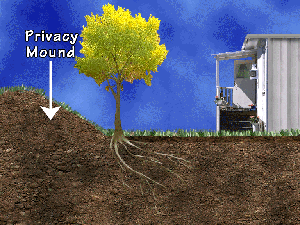After a heavy thunderstorm in Sydney, two large trees from a neighbour’s property fell onto the recently built ‘Burke’s Backyard’ aviary. Some damage occurred to the structure but no birds were lost.
However much it may look like an accident, an incident like this can be avoided as the vast majority of trees that fall over, do so due to human interference. Much of the damage caused to trees and shrubs in gardens during storms is avoidable.
Trees which are uprooted in a storm usually have some pre-existing root disturbance or restriction to root growth. Trees are not inherently unstable and actually protect your house by slowing down the wind.
Why do trees fall over?
There are a number of different ways in which human interference can make a large tree susceptible to falling over in a strong wind.
Changing the drainage patterns around a tree by constructing a house, driveway or path nearby will alter the amount of water the tree receives and cause root death or damage. Trenches dug beside large trees for water, sewer or phone lines will also damage the roots and can make a tree unstable (see diagram A).
Diagram A
Burying tree roots by building something over the top of them or adding more soil, also upsets a tree’s health. Adding extra soil around a tree trunk and over roots prevents both air and water reaching the roots. Privacy mounds built around existing trees for example can cause extensive and long term damage to trees and make them unstable (see Diagram B). Hint: If building a privacy mound put the mound into position then plant trees and shrubs. Keep changes in soil level well away from any established trees.
Diagram B
Planting trees where they shouldn’t be planted can make them unstable. These situations include planting in shallow soil, planting too close to another plant or structure or failing to allow adequate room for a tree to grow and spread.
If you are planting a tree that will grow over 5m (16′) tall you must allow enough room for the roots to spread out and support the tree in every direction. Note: The information on plant labels about the eventual height and spread of a tree may not be correct. Always check details with your nursery at the time you select the tree.
The two trees which fell on the aviary were planted on a rock shelf so the roots could only grow out in one direction (see Diagram C). Without a balanced root system the trees had become increasingly unstable as they grew. The huge leafy canopy they developed acted like a sail, catching the wind and eventually bringing down the tree.
Diagram C
What to do
If a tree falls over in your backyard, seek help from a qualified arborist or tree surgeon. Usually no more expensive than an unqualified person, the arborist will come in and remove the tree safely, clean up the mess without putting your property or himself at risk.
To avoid future tree problems ‘Burke’s Backyard’ recommends never planting large trees within about 10m (30′) of a house (see Diagram D).
Diagram D
When selecting the site for a new tree, make sure there is enough soil for the tree to grow and anchor itself.
Further information
To find a qualified tree surgeon in your area look in the Yellow Pages under ‘Tree Surgery’. Qualified tree surgeons are usually listed as members of the National Arborists Association of Australia.
Tip: Check that any person who comes to work on your property carries adequate and up-to-date insurance.
Further reading
An excellent guide to tree care is Australian Trees: A guide to their care and cure by P. W. Hadlington and J.A. Johnston (UNSW Press, 1977 – reprinted in 1983). ISBN 0 86840 097 1.



